Deutsche Telecom
Deutsche Telekom and Google Cloud partner on “RAN Guardian” AI agent
Deutsche Telekom and Google Cloud today announced a new partnership to improve Radio Access Network (RAN) operations through the development of a network AI agent. Built using Gemini 2.0 in Vertex AI from Google Cloud, the agent can analyze network behavior, detect performance issues, and implement corrective actions to improve network reliability, reduce operational costs, and enhance customer experiences.
Deutsche Telekom says that as telecom networks become increasingly complex, traditional rule-based automation falls short in addressing real-time challenges. The solution is to use Agentic AI which leverages large language models (LLMs) and advanced reasoning frameworks to create intelligent agents that can think, reason, act, and learn independently.
The RAN Guardian agent, which has been tested and verified at Deutsche Telekom, collaborates in a human-like manner, detecting network anomalies and executing self-healing actions to optimize RAN performance. It will be exhibited at next week’s Mobile World Congress (MWC) in Barcelona, Spain.
–>This cooperative initiative appears to be a first step towards building autonomous and self-healing networks.
In addition to Gemini 2.0 in Vertex AI, the RAN Guardian also uses CloudRun, BigQuery, and Firestore to help deliver:
- Autonomous RAN performance monitoring: The RAN Guardian will continuously analyze key network parameters in real time to predict and detect anomalies.
- AI-driven issue classification and routing: The agent will identify and prioritize network degradations based on multiple data sources, including network monitoring data, inventory data, performance data, and coverage data.
- Proactive network optimization: The agent will also recommend or autonomously implement corrective actions, including resource reallocation and configuration adjustments.

“By combining Deutsche Telekom’s deep telecom expertise with Google Cloud’s cutting-edge AI capabilities, we’re building the next generation of intelligent networks,” said Angelo Libertucci, Global Industry Lead, Telecommunications, Google Cloud. “This means fewer disruptions, faster speeds, and an overall enhanced mobile experience for Deutsche Telekom’s customers.”
“Traditional network management approaches are no longer sufficient to meet the demands of 5G and beyond. We are pioneering AI agents for networks, working with key partners like Google Cloud to unlock a new level of intelligence and automation in RAN operations as a step towards autonomous, self-healing networks” said Abdu Mudesir, Group CTO, Deutsche Telekom.
Mr. Mudesir and Google Cloud’s Muninder Sambi will discuss the role of AI agents in the future of network operations at MWC next week.
References:
https://www.telecoms.com/ai/deutsche-telekom-and-google-cloud-team-up-on-ai-agent-for-ran-operations
Nvidia AI-RAN survey results; AI inferencing as a reinvention of edge computing?
The case for and against AI-RAN technology using Nvidia or AMD GPUs
AI RAN Alliance selects Alex Choi as Chairman
AI sparks huge increase in U.S. energy consumption and is straining the power grid; transmission/distribution as a major problem
Deutsche Telekom offers 5G mmWave for industrial customers in Germany on 5G SA network
Deutsche Telekom (DT) has successfully trialed 5G millimeter wave (mmWave) frequencies at 26 gigahertz (GHz) with industrial use cases and is now offering them commercially to industrial customers. For the customer Ger4tech Mechatronik Center, autonomous industrial machines and robots were networked with a router in the 5G campus environment of the Werner-von-Siemens Centre for Industry and Science in Berlin. In addition to the 5G standalone (SA) network in the industrial spectrum at 3.7 GHz, this router also supports mmWave spectrum for the first time. With low latency times of three to four milliseconds RTT (round trip time) and a data rate of over 4 gigabits per second in download and 2 gigabits in upload, mmWave has huge potential in data-intensive applications in the manufacturing industry. The 5G mmWave communications are enabled by Telit Cinterion, a global end-to-end IoT solutions provider.
5G mmWave is playing an increasingly important role in wireless communication technology and imaging, among others. It is characterized by short coverage range and high bandwidth and speeds. It has enormous potential for development within 5G campus networks and for applications in the field of autonomous vehicles and the manufacturing industry. The special ability of mmWave lies in its ability to transmit large amounts of data in real time. The frequency spectrum around 26 GHz is allocated exclusively to interested parties in Germany by the Federal Network Agency. It can currently only be used for local applications.
“It is important for our industrial customers in the age of artificial intelligence to be able to upload data from machines and thus make it available and analyzable in real time,” explains Klaus Werner, Managing Director Business Customers at Telekom Deutschland GmbH. “This is the only way for companies to introduce AI applications sensibly and efficiently and derive great benefits for their business,” he added.
“We’re enabling customers to access unparalleled levels of efficiency, productivity and innovation. Through the seamless integration of 5G mmWave into their operations, every device and process can achieve connectivity at an unprecedented scale,” said Marco Contento, VP of Product Management, Mobile Broadband at Telit Cinterion. “Collaboratively, we’re helping to pave the way for industries to streamline operations, anticipate maintenance needs, and a multitude of future possibilities.”
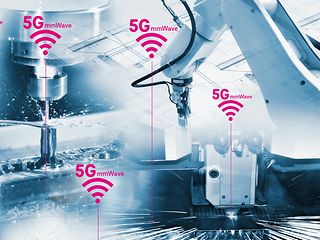
The 5G standalone campus network at the Werner-von-Siemens Centre operates separately from Telekom’s public mobile network. The entire infrastructure, from the antennas and active system technology to the core network, comes from Ericsson. Based on this network, a fleet of autonomously driving and operating robots works on various use cases at the center. The 5G standalone network is often sufficient to control the robots. The 5G millimeter waves come into play when the requirements for communication and data transmission increase, and therefore also when solving more complex tasks. For example, in a computer vision application: the robot picks up an order and checks whether the ordered goods are complete on the way to the next destination. If there is a discrepancy, it immediately reorders the goods.
In addition to these, many other scenarios are mapped in the Werner-von-Siemens Centre. Here, industry, research institutions (including TU Berlin and Fraunhofer), small and medium-sized enterprises and start-ups work on practical solutions for companies – including for autonomous production logistics and other challenges in industrial manufacturing.
In the UK, regulator Ofcom launched a new consultation in April and the sector is awaiting the details of when and in what form an auction will take place.
Additional Resources:
About Ger4Tech Mechatronik Center
About Telit Cinterion
……………………………………………………………………………………………………………………………………………………
References:
https://www.telecoms.com/5g-6g/deutsche-telekom-looking-to-flog-5g-mmwave-to-industrial-sector
Daryl Schoolar: 5G mmWave still in the doldrums!
Deutsche Telekom migrates IP-based voice telephony platform to the cloud
Deutsche Telekom has successfully transitioned its IP-based voice telephony platform to the cloud. Landline connections are now centrally controlled from cloud data centers in Germany. Over seventeen million customer connections have been migrated. Billions of voice minutes are now handled entirely through the NIMS platform (NIMS: Next Generation IP Multimedia Subsystem) with around 100 interconnect partners.
Thanks to disaggregation, services can be provided through an optimized solution portfolio of software modules from a wide ecosystem of industry partners. The near-complete automation of the Telco Cloud provides a more efficient process, leading to significantly more flexibility and speed in the introduction of new service features and capacity expansion.
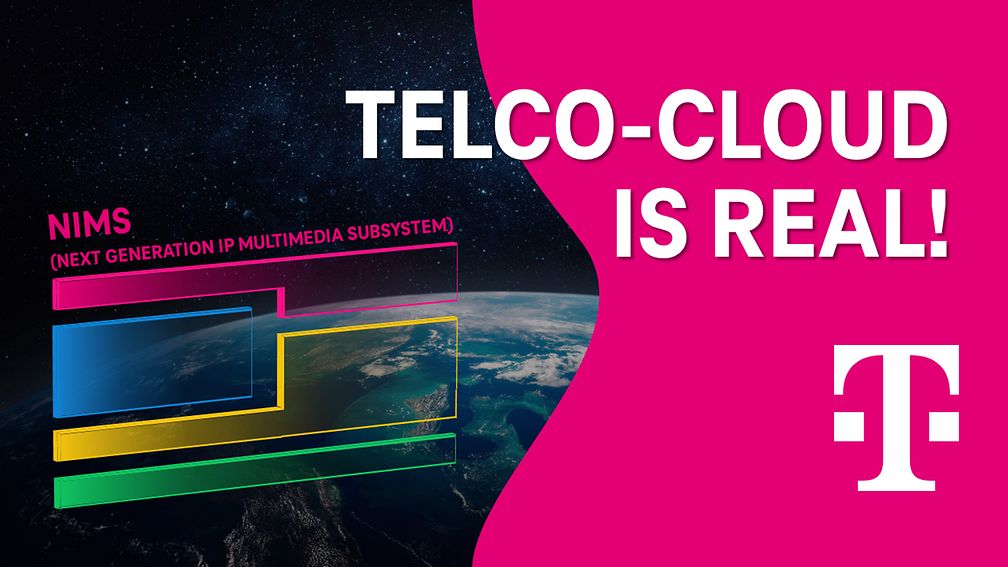
Image credit: Deutsche Telekom
“This project is a game changer in the industry,” says Abdu Mudesir, Chief Technology Officer of Deutsche Telekom Deutschland. “It is the result of excellent cooperation with partners such as Juniper Networks, Mavenir, Microsoft, HPE, Red Hat, and Lenovo. Our common goal in this innovation project has always been to set a benchmark for excellence in the industry, for our customers. The success has spread, many network operators are now asking us specifically how we managed to achieve this.”
“The cloud isn’t just a technology, but rather an entirely new operating model that can yield tremendous agility, cost efficiencies and better user experiences. I am so proud that Juniper was able to play a role in bringing Deutsche Telekom’s visionary strategy for NIMS to life and even more thrilled to see this project, which I consider a blueprint for the rest of the telecom industry, now complete,” says Rami Rahim, CEO – Juniper Networks.
“With NIMS, Deutsche Telekom has leveraged the benefits of cloud native network functions, hyper scaler technology and extreme automation to deliver mission critical carrier grade performance; it’s a huge step forward in the Telecommunications industry,” says Yousef Khalidi CVP, Azure for Operators – Microsoft.
“Telekom´s vision was unique because it was not just a pure technology play. Its goal to change the old development paradigms, driving automation and interoperability into the very fabric of the Telco Cloud architecture. The NIMS platform offers a transformative lifecycle automation for all telco cloud and payload components and Mavenir is proud to be part of the multi-vendor ecosystem delivering this innovation,” says Bejoy Pankajakshan, EVP & Chief Technology and Strategy Officer of Mavenir.
“The platform is a key building block for ´Zero Touch operations´ where manual intervention and operations to handle network management and configuration are reduced in favor of a more advanced, software-based solution,” says David Stark, VP & GM, Telco Solutions – HPE.
Telekom has already established follow-up projects to consistently implement the successful model of cloudification, disaggregation, and complete automation in other voice applications, 5G Core and the access networks.
References:
Deutsche Telekom Network Day: Fiber, Mobile Network, Open RAN and 5G SA Launch in 2024
SK Telecom and Deutsche Telekom to Jointly Develop Telco-specific Large Language Models (LLMs)
Deutsche Telekom with AWS and VMware demonstrate a global enterprise network for seamless connectivity across geographically distributed data centers
Deutsche Telekom exec: AI poses massive challenges for telecom industry
Deutsche Telekom’s fiber optic expansion in 140 of the 179 municipalities within the Gigabit region of Stuttgart
Deutsche Telekom Global Carrier Launches New Point-of-Presence (PoP) in Miami, Florida
Deutsche Telekom Network Day: Fiber, Mobile Network, Open RAN and 5G SA Launch in 2024
2023 Deutsche Telekom (DT) Highlights:
- Fiber offensive: more than 2.5 million new fiber connections made possible in 2023, reaching a total of more than ten million fiber households in 2024
- 5G front-runner: 5G population coverage of 96%, 5G Standalone also for private customers in 2024
- State-of-the-art technologies: Artificial intelligence supports fiber and mobile rollout
- EURO 2024: Deutsche Telekom connects all stadiums, fan zones & team quarters, data gift for all mobile customers
………………………………………………………………………………………………………………………………………
DT Network Day photo courtesy of Deutsche Telekom
………………………………………………………………………………………………………………………………………
Deutsche Telekom announced that it has successfully enabled more than 2.5 million new fiber connections this year, thereby realizing its fiber plant expansion target. The company invested EUR 2.5 billion in fiber expansion, expanding coverage in almost 3,500 towns and municipalities. According to the announcement, the company projects a total investment of EUR 30 billion in the fiber optic rollout by 2030.
Its Fiber-to-the-home (FTTH) network is set to reach eight million households by the end of the year, with plans to extend this to ten million fiber optic connections by 2024.
………………………………………………………………………………………………………………………………………..
In mobile, Deutsche Telekom currently provides 5G coverage to 96 percent of the population, serving 80 million people through a network of over 80,000 5G antennas, including 10,000 in the 3.5 GHz band spread across more than 800 cities and municipalities. The network delivers download speeds of up to 1 Gbps.
The company aims to achieve 99 percent 5G coverage for the German population by 2025 and plans to launch 5G Standalone (SA) core network for private customers in 2024. DT indicates that 10,000 antennas are compatible with 5G SA in the 3.6 GHz band, covering more than 800 cities and municipalities. This is up from 9,700 antennas in August 2023.
Deutsche Telekom’s business customers are already using 5G SA technology with functions such as network slicing. For example, for live TV transmission of media or in 5G campus networks for industry and research. “In the coming year, 5G SA should then offer all customers real added value,” DT said.
Meanwhile, rival operators Telefónica Deutschland (O2 Germany) and Vodafone Germany already offer standalone 5G services.
…………………………………………………………………………………………………………………………
DT began the deployment of its open radio access network (O-RAN) in Germany in December, in collaboration with Nokia and Fujitsu. The first O-RAN commercial deployment will be in Neubrandenburg. Nokia and Fujitsu are supplying the necessary technology components.
“Open RAN increases the choice of manufacturers and therefore our flexibility. The open access network enables more automation. And makes our networks even more resilient. This benefits the people that our mobile network connects,” says Claudia Nemat.
The German telco expects to have 3,000 O-RAN compatible antennas by the end of 2026.
…………………………………………………………………………………………………………………………
Deutsche Telekom also says it’s using Artificial Intelligence (AI) in network expansion and mobile communications. AI aids in analyzing and evaluating cell usage and capacity utilization, with the ongoing development of a large language model for telco-specific applications in collaboration with SK Telekom. Additionally, AI contributes to enhanced network security through automated pattern recognition, according to the company.
References:
https://www.telekom.com/en/media/media-information/archive/telekom-network-day-2023-1055364
https://www.fiercewireless.com/wireless/deutsche-telekom-plans-5g-standalone-launch-2024
SK Telecom and Deutsche Telekom to Jointly Develop Telco-specific Large Language Models (LLMs)
SK Telecom and Deutsche Telekom announced that they signed a Letter of Intent (LOI) to jointly develop a telco-specific Large Language Models (LLMs) that will enable global telecommunication companies (telcos) to develop generative AI models easily and quickly. The LOI signing ceremony took place at SK Seorin Building located in Seoul with the attendance of key executives from both companies including Ryu Young-sang, CEO of SKT, Chung Suk-geun, Chief AI Global Officer of SKT, Tim Höttges, CEO of Deutsche Telekom, Claudia Nemat, Board Member Technology and Innovation of Deutsche Telekome, and Jonathan Abrahamson, Chief Product and Digital Officer of Deutsche Telekom.
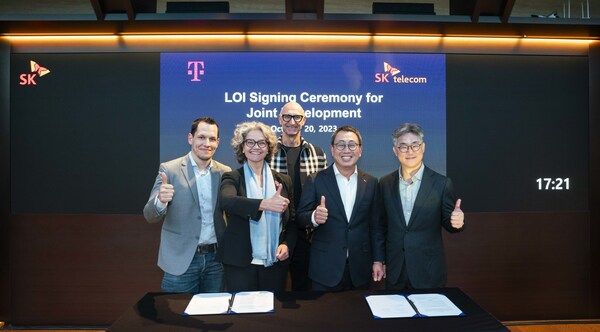
SK Telecom and Deutsche Telekom to Jointly Develop Telco-specific LLM
This marks the first fruition of discussions held by the Global Telco AI Alliance, which was launched by SKT, Deutsche Telekom, E&, and Singtel, in July 2023, and lays the foundation to enter the global market. SKT and Deutsche Telekom plan to collaborate with AI companies such as Anthropic (Claude 2) and Meta (Llama2) to co-develop a multilingual – i.e, German, English, Korean, etc. – large language model (LLM) tailored to the needs of telcos. They plan to unveil the first version of the telco-specific LLM in the first quarter of 2024.
The telco-specific LLM will have a higher understanding of telecommunication service-related areas and customer’s intentions than general LLMs, making it suitable for customer services like AI contact center. The goal is to support telcos across the world, including Europe, Asia, and the Middle East, to develop generative AI services such as AI agents flexibly according to their respective environment. That will enable telcos to save both time and cost for developing large platforms, and secure new business opportunities and growth engines through AI innovation that shifts the paradigm in the traditional telecommunications industry. To this end, SKT and Deutsche Telekom plan to jointly develop AI platform technologies that telcos can use to create generative AI services to reduce both development time and cost.
For instance, when a telco tries to build an AI contact center based on generative AI, it itself will be able to build one that suits their environment more quickly and flexibly. In addition, AI can be applied to other areas such as network monitoring and on-site operations to increase efficiency, resulting in cost savings in the mid- to long-term.
Through this collaboration, the two companies will proactively respond to the recent surge in AI demand from telcos, while also promoting the expansion of the global AI ecosystem through the successful introduction of generative AI optimized for specific industries or domains.
“AI shows impressive potential to significantly enhance human problem-solving capabilities. To maximize its use especially in customer service, we need to adapt existing large language models and train them with our unique data. This will elevate our generative AI tools,” says Claudia Nemat, Member of the Board of Management for Technology and Innovation at Deutsche Telekom.
“Through our partnership with Deutsche Telekom, we have secured a strong opportunity and momentum to gain global AI leadership and drive new growth,” said Ryu Young-sang, CEO of SKT. “By combining the strengths and capabilities of the two companies in AI technology, platform and infrastructure, we expect to empower enterprises in many different industries to deliver new and higher value to their customers.”
References:
Global Telco AI Alliance to progress generative AI for telcos
Cloud Service Providers struggle with Generative AI; Users face vendor lock-in; “The hype is here, the revenue is not”
Bain & Co, McKinsey & Co, AWS suggest how telcos can use and adapt Generative AI
Generative AI Unicorns Rule the Startup Roost; OpenAI in the Spotlight
Generative AI in telecom; ChatGPT as a manager? ChatGPT vs Google Search
Generative AI could put telecom jobs in jeopardy; compelling AI in telecom use cases
Google Cloud infrastructure enhancements: AI accelerator, cross-cloud network and distributed cloud
Cloud infrastructure services market grows; AI will be a major driver of future cloud service provider investments
TPG, Ericsson launch AI-powered analytics, troubleshooting service for 4G/5G Mobile, FWA, and IoT subscribers
Deutsche Telekom with AWS and VMware demonstrate a global enterprise network for seamless connectivity across geographically distributed data centers
Deutsche Telekom (DT) has partnered up with AWS and VMware to demonstrate what the German network operator describes as a “globally distributed enterprise network” that combines Deutsche Telekom connectivity services in federation with third party connectivity, compute, and storage resources at campus locations in Prague, Czech Republic and Seattle, USA and an OGA (Open Grid Alliance) grid node in Bonn, Germany.
The goal is to allow customers to book connectivity services directly from DT using a unified interface for the management of the network across its various locations.
The POC demonstrates how the approach supports an optimized resource allocation for advanced AI based applications such as video analytics, autonomous vehicles and robotics. The demonstration use case is video analytics with distributed AI inference.
PoC setup:
The global enterprise network integrates Deutsche Telekom private 5G wireless solutions, AWS services and infrastructure, VMware’s multi-cloud telco platform, OGA grid nodes and Mavenir’s RAN/Core functions. Two 5G Standalone (SA) private wireless networks deployed at locations in Prague, Czech Republic and Seattle, USA are connected to a Mavenir 5G Core hosted on AWS Frankfurt Region leveraging the framework of the Integrated Private Wireless on AWS program. The convergence of the global network with local high-speed 5G connectivity is enabled by the AWS backbone and infrastructure.
The 5G SA private wireless network with User Plane Function (UPF) and RAN hosted at the Seattle location, is operating on the VMware Telco Cloud Platform to enable low latency services. The VMware Service Management and Orchestration (SMO) is also deployed in the same location and serves as the global orchestrator. The SMO framework helps to simplify, optimize and automate the RAN, Core and its applications in a multi-cloud environment.
To demonstrate the benefit of this approach, the deployed POC used a video analytics application where cameras were installed at both Prague and Seattle locations and connected through a private wireless global enterprise network. Using this approach, operators were able to run AI components concurrently for immediate analysis and inferencing. This helps demonstrate the ability for customers to seamlessly connect devices across locations using the global enterprise network. Leveraging OGA architectural principles for Distributed Edge AI Networking, an OGA grid node was established on Dell infrastructure in Bonn facilitating seamless connectivity across the European locations.
Statements:
“As AI gets engrained deeper in the ecosystem of our lives, it necessitates equitable access to compute and connectivity for everyone, everywhere across the globe. Multi-national enterprises are seeking trusted and sovereign compute & connectivity constructs that underpin an equitable and seamless access. Deutsche Telekom is excited to partner with the OGA ecosystem for co-creation on these essential constructs and the enablement of the Distributed Edge AI Networking applications of the future,” – Kaniz Mahdi, Group Chief Architect and SVP Technology Architecture and Innovation at Deutsche Telekom.
“VMware is proud to support this Proof of Concept – contributing know-how and a modern and scalable platform that aims to offer the agility required in distributed environments. VMware Telco Cloud Platform is suited to deliver the compute resources on-demand wherever critical customer workloads are needed. As a founding member of the Open Grid Alliance, VMware embraces both the principles of this initiative and the opportunity to collaborate more deeply with fellow alliance members AWS and Deutsche Telekom to help meet the evolving needs of global enterprise customers.” – Stephen Spellicy, vice president, Service Provider Marketing, Enablement and Business Development, VMware
References:
https://www.telekom.com/en/media/media-information/archive/global-enterprise-network-1050910
Deutsche Telekom Global Carrier Launches New Point-of-Presence (PoP) in Miami, Florida
AWS Integrated Private Wireless with Deutsche Telekom, KDDI, Orange, T-Mobile US, and Telefónica partners
Deutsche Telekom Achieves End-to-end Data Call on Converged Access using WWC standards
Deutsche Telekom exec: AI poses massive challenges for telecom industry
Deutsche Telekom’s fiber optic expansion in 140 of the 179 municipalities within the Gigabit region of Stuttgart
Deutsche Telekom said it has deployed its fiber optic network in more than 140 of the 179 municipalities covered by its agreement with the “gigabit region” of Stuttgart. The German network operator has developed its network in the districts of Boeblingen, Esslingen, Goeppingen, Ludwigsburg and Rems-Murr districts.With ongoing expansion efforts at over 58 construction sites, the company is making significant progress, particularly in nine districts in Stuttgart, according to the statement from the company.
Since 2019, Telekom has accounted for more than 90 percent of the growth in fiber optic infrastructure. As the sole company expanding into both rural and urban areas, Telekom has established itself as a reliable partner, delivering on all construction projects and cooperation agreements, according to the broadband officer of the region and managing director of Gigabit Region Stuttgart (GRS).
In Ludwigsburg and Esslingen alone, Telekom has already been awarded contracts for 76 funding projects. The recent collaboration with Stadtwerke Nuertingen serves as a prime example of Telekom’s cooperative efforts.
Currently, approximately 30,000 households in expansion areas under this partnership can already subscribe to Telekom’s fibre optic connections. The long-term goal is to enable 185,000 households within cooperative areas with municipal utilities to choose their preferred communication provider for fibre optic connections by 2030.
The combined efforts of self-expansion, collaborations, and subsidized projects have granted around 335,000 households throughout the region access to the fibre optic network, Telekom said.
The core focus of the gigabit project is to expand the ultra-fast fiber optic network through strategic partnerships. Currently, 177 municipalities, including Stuttgart and the neighbouring districts of Boeblingen, Esslingen, Goeppingen, Ludwigsburg, and Rems-Murr, are participating in the expansion program.
The project aims to provide 50 percent of households, all companies, and schools with fiber optic connectivity by 2025. By 2030, the target is to achieve 90 percent household coverage. With a population of approximately 2.8 million in the conurbation, other companies in the Stuttgart region are also actively involved in fiber optic expansion initiatives said Telekom.

Telekom includes provisions for rapidly expanding the performance of its 5G network. Presently, almost 95 percent of households can already access 5G in Telekom’s mobile network, while over 99 percent of the population can utilize 4G/LTE connectivity.
Significance of DT Tower Sales:
Deutsche Telekom said proceeds from the sale of its tower business helped reduce net debt excluding leases by over 10 billion euros compared with the end of 2022, to 93 billion euros. The transaction was also the main factor behind the near quadrupling of net profit, to 15.4 billion euros, compared with the same period last year, the company said.
Deutsche Telekom had agreed in July 2022 to sell 51% of its tower business in Germany and Austria to a consortium of Canada’s Brookfield and U.S. private equity firm DigitalBridge after they made a surprise last-minute bid that valued the unit at 17.5 billion euros ($17.5 billion).
References:
New DT campus network solution with industrial 5G spectrum
Deutsche Telekom (DT) announced a new campus network solution for business customers. The new service, named “Campus Network M with Industrial Frequencies,” will offer business customers all the benefits of a private 5G network — without the need for additional investments in their own 5G SA core network.
- New Deutsche Telekom business customer offer enables cost-effective use of own 5G industrial frequencies in the 3.7 to 3.8 GHz range
- Solution combines advantages of public and fully private mobile networks for industrial applications
- Successful pilot with German machine manufacturer Arburg. The commercial launch followed successful tests in the 5G Campus network of the injection molding machine manufacturer Arburg in January 2023.
- Based on a 5G campus infrastructure within Telekom’s public network, with the new product companies can additionally use their own 5G industrial frequencies in the 3.7 to 3.8 Gigahertz (GHz) range exclusively.
The new DT solution is based on the existing business customer product “Campus Network M”. This is a so-called dual-slice campus network, which is operated via the public 3.6 GHz frequency range in Telekom’s 5G network. It combines the strengths of the public 5G network with the exclusivity of a virtual private network. This means that, on the one hand, companies benefit from optimal and stable coverage via Telekom’s public 5G network – for example, for employees, suppliers or customers. On the other hand, mission-critical data traffic, for example from machinery, runs separately by a virtual private network and can also be prioritized.
The new Campus-Network M product with industrial frequencies goes one step further. Without building additional infrastructure and the associated costs, companies benefit from the exclusivity of the local 5G spectrum in the 3.7 to 3.8 GHz range. Other than Telekom’s public 3.6 GHz spectrum, these 5G frequencies are specifically made available by the German Federal Network Agency for industrial purposes. Previously, to use these purely private frequencies companies would need to install their own 5G core network infrastructure on site. With the new solution, however, business customers get their own core network components within the Telekom network. Critical data thus continues to run separately from the public network – at high bandwidths and without being influenced by public data traffic. With considerable cost synergies through shared components, the customer therefore receives an additional purely private campus network.
The new offering enables the use of exclusive SIM cards for connected devices and guarantees full private 5G network performance with download speeds of up to 1GBit/s. At the same time, public 5G coverage is fully available. This provides customers with two 5G frequency bands and a total of around 190 MHz of bandwidth.
“Our new 5G Campus network offering enables our customers to digitalize and optimize their business in a smarter way. By integrating their own spectrum into local 5G networks in a cost-efficient way, companies now get additional and exclusive 5G bandwidth for their digital applications,” says Hagen Rickmann, Managing Director responsible for Business Customers at Telekom Deutschland GmbH. “In this way, our pilot customer Arburg is already benefiting from the huge potential of private 5G performance for smart manufacturing – and is thus living up to its reputation as pioneer in the fields of production efficiency and digitalization.”
In order to use the industrial frequencies, the machines at the Arburg Customer Center in Lossburg were equipped with special routers and exclusive SIM cards. Separated from the public data traffic, Arburg can thus test innovative applications such as automated production processes. Furthermore, at the customer center, clients from the various plastics processing industries, such as the automotive, electrical and packaging industries or medical technology, can test digital manufacturing concepts based on 5G.
“By integrating Deutsche Telekom’s new 5G Campus solution, we are leveraging synergies and kick-starting the next stage when it comes to digitalization for the efficient production of plastic products,” says Jürgen Boll, Managing Director Finance, Controlling and IT at Arburg. “Without any additional structural measures, we were able to build on the existing campus network and can benefit from even more 5G bandwidth for the digitalization of our machines and systems with our own 5G industrial frequencies.”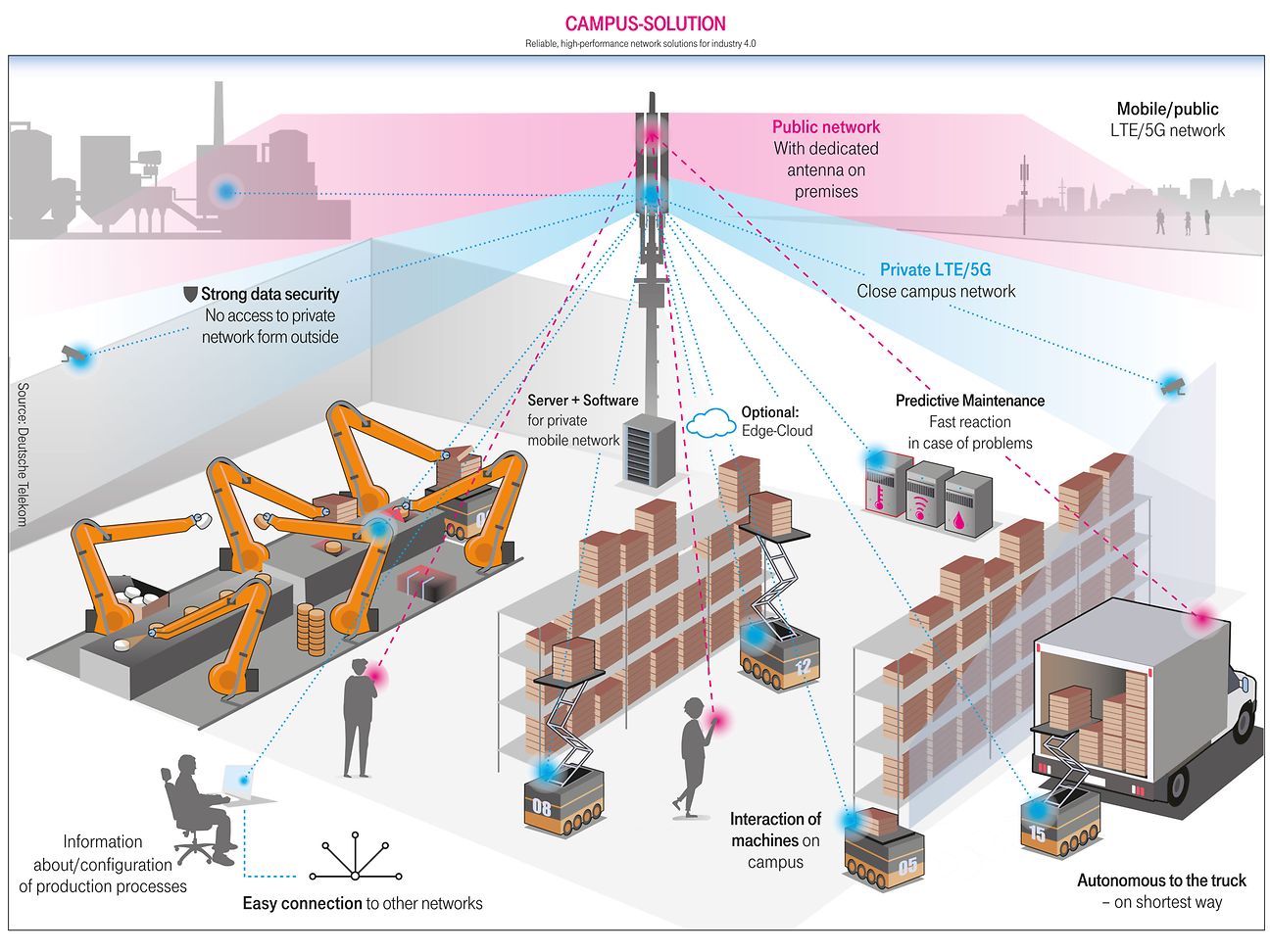
Image Credit: Deutsche Telekom
…………………………………………………………………………………………………………………………………………………………………………..
Deutsche Telekom’s campus network portfolio:
Deutsche Telekom has been offering campus network solutions for companies since 2019 and currently operates more than thirty of these local mobile networks based on 5G or LTE across Germany. The offering ranges from locally reinforced public mobile service on company premises to the company’s own private campus network based on 5G standalone technology. Further information for business customers is available at www.telekom.de/campus-netze.
References:
https://www.telekom.com/en/company/details/5g-technology-in-campus-networks-556692
Deutsche Telekom to deploy more small cells to solidify its 5G network
Deutsche Telekom plans to deploy more small cells to solidify its 5G network, the company said in a podcast. The carrier explained that small cells improve the quality of the network in areas of high density, such as train or bus stations, markets or shopping arcades.
In late December, Deutsche Telekom said it would repurpose approximately 3,000 old public payphones as 5G small cells by 2025. They will have a range of a few hundred meters and will serve city centres and pedestrian zones using the 3.6 GHz frequency band. Telekom said its 5G small cells serve a 200-metre radius.
Telekom already uses phone box small cells for LTE networks on the 2.6GHz frequency, but will start a 5G rollout using the 3.6GHz band in 2023, having completed a pilot phase.
Telekom stressed its enthusiasm for designs that “fit in with the urban landscape, either by standing out with a decorative design or by harmoniously blending into their surroundings”. The latest roll out of phone box small cells will see 5G connectivity with little to no visual impact on German streets.
Telekom has partnered with Swiss network equipment vendor Huber+Suhner on small cells since 2019, using them to densify its 4G network across a number of German cities. The Huber+Suhner kit is installed in existing street furniture — including phone boxes — operating over a range of frequencies from 1.7GHz to 4.2GHz. When the deal was signed, then-Chief Technology Officer Walter Goldenits said that small cells would form an “important component of our expansion strategy”. He added that the Swiss vendor’s equipment can be converted to support 5G networks “in a few easy steps” (Deutsche Telekomwatch, #87). With this latest phone box small-cell rollout, it appears that this option has not been taken.
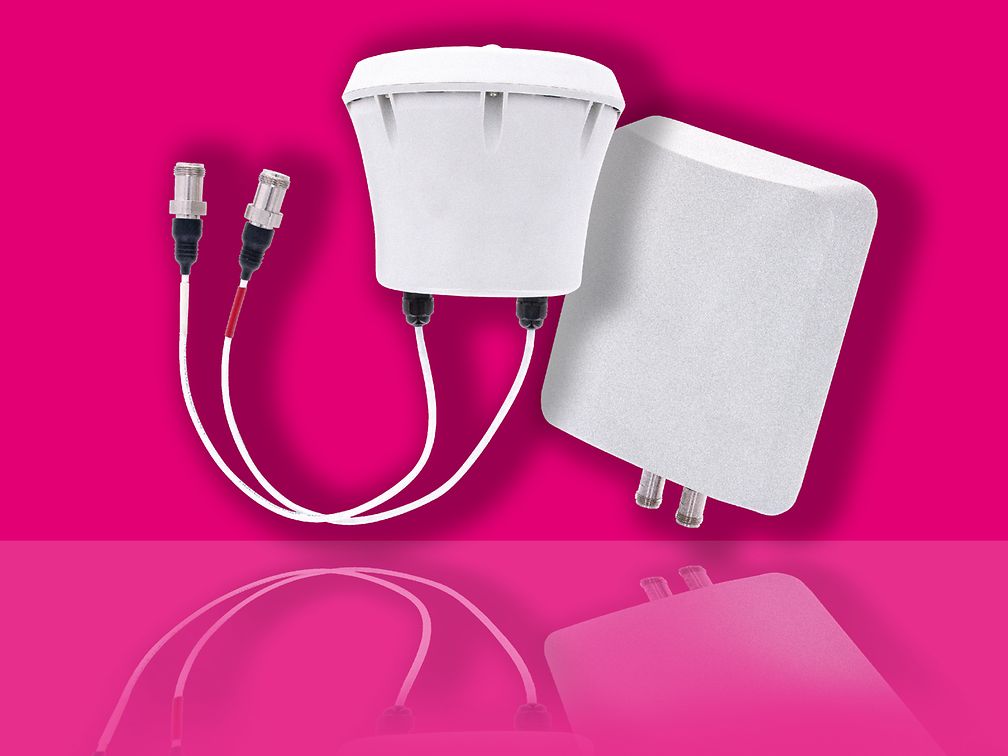
5G small cell antennas. © Deutsche Telekom AG
Deutsche Telekom Technik, the operator’s German network deployment and management unit, has been trialling street-level 5G small-cell designs since at least 2019. Then, it highlighted “creative designs” to densify the network, including the use of antenna housings shaped like clocks and birds perching on lampposts.
References:
https://www.telekom.com/en/search-this-website?query=small+cells++
https://www.telekom.com/en/media/media-information/archive/5g-small-cell-antennas-579790
Deutsche Telekom Achieves End-to-end Data Call on Converged Access using WWC standards
Wireline and wireless services are delivered today from two distinct technology implementations with separate network cores. 5G WWC standards offer a path to a fully converged broadband access network that integrates wireless and wireline operations on a common 5G Core.
Using these 5G Wireless Wireline Convergence (WWC) standards [1.] in an industry first proof-of-concept, Deutsche Telekom has validated in a lab trial the feasibility of converging the fixed network control plane into a 5G Core to steer traffic from a 5G residential gateway in its Bonn laboratory. The traffic was then routed along the entire wireline access chain to the core network.
Note 1. The GSMA’s 3rd Generation Partnership Project (3GPP), the Broadband Forum (BBF) and CableLabs have united to create technical reports and specifications defining the services and systems required to support 5G wireless and wireline convergence (5G WWC) architectures. Their resulting work is detailed within BBF’s TR-456 (Fixed Mobile Convergence / FMC) and CableLabs WR-TR-5WWC-ARCH and rolled-up within 3GPP Release 16 Technical Specification TS 23.316. The IETF have also been engaged in providing guidance around user plane protocol revisions while the IEEE, ITU-T SG15 and Metro Ethernet Forum (MEF) have been engaged with timing/synchronization requirements and other service specifications.
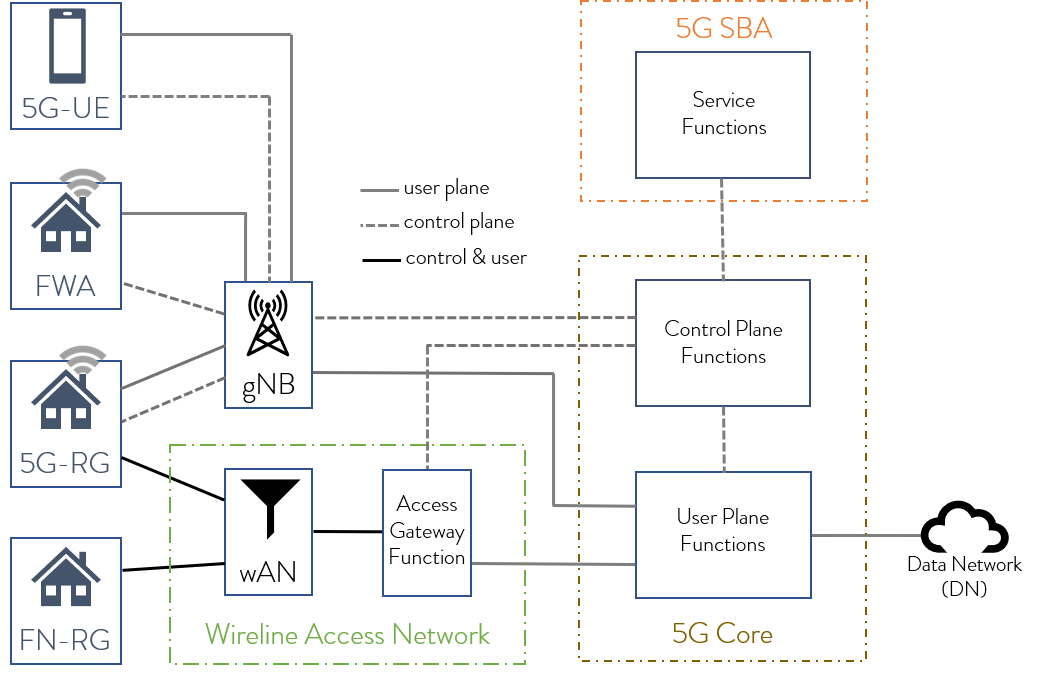
The Access Gateway Function (AGF) supporting wireless wireline convergence in a 5G Core
“Convergence will allow us to optimize our network assets and deliver new, differentiated service experiences to our customers regardless of the access used,” says Ahmed Hafez, VP Network Convergence, Deutsche Telekom. „Our tests prove the feasibility of the convergence architecture by controlling residential gateways in our fixed network from a common 5G Core.
It is critical now that the vendor ecosystem implements the standards into their product roadmaps, speeding up the time to market for end-to-end convergent solutions.”
The proof of concept was conducted on a trial system in Deutsche Telekom’s lab environment. For the 5G residential gateway, which provides the connection between the networked equipment within a home or small office to the 5G Core, a Deutsche Telekom developed prototype was used.
5G Core as common core:



